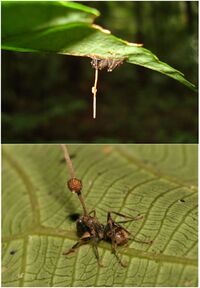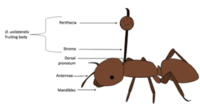Ophiocordyceps unilateralis: Difference between revisions
No edit summary |
|||
| (28 intermediate revisions by the same user not shown) | |||
| Line 1: | Line 1: | ||
{| class="wikitable" style="text-align:center; float:right; margin-left: 10px; | {| class="wikitable" style="text-align:center; float:right; margin-left: 10px; | ||
|+ !colspan="2" style="min-width:12em; text-align: center; background-color: rgb(235,235,210)|'''Scientific Classification''' | |+ !colspan="2" style="min-width:12em; text-align: center; background-color: rgb(235,235,210)|'''Scientific Classification''' | ||
|- | |- | ||
| Line 29: | Line 28: | ||
=Ophiocordyceps unilateralis= | =Ophiocordyceps unilateralis= | ||
Commonly known as the zombie-ant fungus, Ophiocordyceps | [[File:Zombie ant photo.jpeg|200px|Thumb|right|]] | ||
Commonly known as the zombie-ant fungus, Ophiocordyceps unilateralism is an insect-pathogenic fungus that was first discovered in 1859 by British naturalist Alfred Russel Wallace. O. unilateralis typically infects a specific ant host species called Camponotus leonardi but has been known to parasitize ants of other closesly related species to a lesser degree of effectiveness in terms of reproductive success and manipulation. Once infected, hosts are controlled to leave their nests in the tree canopy for environmental conditions more suitable for fungal growth. Upon reaching an area with ideal humidity and temperature conditions, the host uses their mandibles to lock on to a major vein on the underside of a leaf where they remain to die. [1] This process may take up to 10 days ultimately ending with the fungal reproductive stage where a fruiting body is created to produce more spores to infect future hosts. | |||
==Description== | ==Description== | ||
[[File:18B9217B-CCB4-4DFF-BB9C-23ED2EFCC0BF.png |200px|thumb|O. unilateralis growing out of an infected host ant]] | [[File:18B9217B-CCB4-4DFF-BB9C-23ED2EFCC0BF.png |200px|thumb|O. unilateralis growing out of an infected host ant]] | ||
Once the reproductive structure becomes visible on the dead host, Ophiocordyceps unilateralis is easily identifiable. This fungus normally creates a single darkly colored stroma just below the head of the dead ant hose in an area refereed to as the pronotum region. [5] Just below the tip of the stroma, the perithecia (spore producing reproductive structure) can be observed. | |||
==Habitat and Range== | ==Habitat and Range== | ||
| Line 39: | Line 40: | ||
==Host Impact== | ==Host Impact== | ||
[[File:Zombie ant life cycle.png |400px|thumb|Behavioral manipulation of an ant caused by products secreted by O. unilateralis]] | [[File:Zombie ant life cycle.png |400px|thumb|Behavioral manipulation of an ant caused by products secreted by O. unilateralis]] | ||
O. unilateralis has the potential to kill entire ant colonies. Infected ants tend to die in areas of densely populated ant travel resulting in areas appropriately named "graveyards". These areas can be up to 30 meters in range with deceased any density dependent on climatic conditions. Studies have shown that temperature and humidity can have have a direct influence on host populations specifically because of O. unilateralis growth potential. Seasonal patterns of dead ants show a decrease during the dry seasons and increase during the rainy seasons. [1] | |||
==Life Cycle== | |||
Typically, the ant species Camponotus leonardi live in the high canopies of tropical forests where they create a network of aerial trails. Sometimes, trails can become broken creating gaps that are too difficult to cross. In this case, the ants must descend down to the forest floor where they can be exposed to Ophiocordyceps unilateralis spores. Spores attach to the exoskeleton of the ant where they eventually break through using enzymes and mechanical pressure. Yeast stages cause the fungus to spread throughout the ants body where they produce compounds that presumably affect the ant's circulatory system to manipulate the behavioral pattern of the host. Notably, ants will experience irregularly timed, full-body convulsions that dislodge the ant from the canopy to fall to the forest floor. [6] | |||
Infected ants begin to experience very specific changes in behavior which give rise to the popular "zombie-ant" naming. Behaviors are modified to improve conditions for the fungus in terms of growth and future transmission. Infected ants will climb up stems of plants where they use abnormal force to clamp down on a main vein of a leaf using their mandibles. Once secure, ants remain there until they die and reproductive structures sprout from their body. Eventually, additional spores are released to attach to new hosts. | |||
==References== | ==References== | ||
| Line 51: | Line 55: | ||
[4] Araújo JP, Evans HC, Kepler R, Hughes DP (June 2018). "Ophiocordyceps. I. Myrmecophilous hirsutelloid species". Studies in Mycology. 90: 119–160. | [4] Araújo JP, Evans HC, Kepler R, Hughes DP (June 2018). "Ophiocordyceps. I. Myrmecophilous hirsutelloid species". Studies in Mycology. 90: 119–160. | ||
[5] Evans HC, Elliot SL, Hughes DP (September 2011). "Ophiocordyceps unilateralis: A keystone species for unraveling ecosystem functioning and biodiversity of fungi in tropical forests?". Communicative & Integrative Biology. 4 (5): 598–602 | |||
[6] Hughes DP, Andersen SB, Hywel-Jones NL, Himaman W, Billen J, Boomsma JJ (May 2011). "Behavioral mechanisms and morphological symptoms of zombie ants dying from fungal infection". BMC [[Ecology]]. 11 (1): 13 | |||
Latest revision as of 20:09, 12 May 2022
| Kingdom: | Fungi |
|---|---|
| Division: | Ascomycota |
| Class: | Sordariomycetes |
| Order: | Hypocreales |
| Family: | Ophiocordycipitaceae |
| Genus: | Ophiocordyceps |
| Species: | O. unilateralis |
Ophiocordyceps unilateralis

Commonly known as the zombie-ant fungus, Ophiocordyceps unilateralism is an insect-pathogenic fungus that was first discovered in 1859 by British naturalist Alfred Russel Wallace. O. unilateralis typically infects a specific ant host species called Camponotus leonardi but has been known to parasitize ants of other closesly related species to a lesser degree of effectiveness in terms of reproductive success and manipulation. Once infected, hosts are controlled to leave their nests in the tree canopy for environmental conditions more suitable for fungal growth. Upon reaching an area with ideal humidity and temperature conditions, the host uses their mandibles to lock on to a major vein on the underside of a leaf where they remain to die. [1] This process may take up to 10 days ultimately ending with the fungal reproductive stage where a fruiting body is created to produce more spores to infect future hosts.
Description

Once the reproductive structure becomes visible on the dead host, Ophiocordyceps unilateralis is easily identifiable. This fungus normally creates a single darkly colored stroma just below the head of the dead ant hose in an area refereed to as the pronotum region. [5] Just below the tip of the stroma, the perithecia (spore producing reproductive structure) can be observed.
Habitat and Range
Ophiocordyceps unilateralis is considered pantropical as it mainly exists in tropical forest ecosystems located in Australia, Brazil, and Thailand. However, there have been recent discoveries of this fungus also existing in warm-temperate ecosystems such as the temperate forests found in Florida, South Carolina, and Japan. [4]
Host Impact

O. unilateralis has the potential to kill entire ant colonies. Infected ants tend to die in areas of densely populated ant travel resulting in areas appropriately named "graveyards". These areas can be up to 30 meters in range with deceased any density dependent on climatic conditions. Studies have shown that temperature and humidity can have have a direct influence on host populations specifically because of O. unilateralis growth potential. Seasonal patterns of dead ants show a decrease during the dry seasons and increase during the rainy seasons. [1]
Life Cycle
Typically, the ant species Camponotus leonardi live in the high canopies of tropical forests where they create a network of aerial trails. Sometimes, trails can become broken creating gaps that are too difficult to cross. In this case, the ants must descend down to the forest floor where they can be exposed to Ophiocordyceps unilateralis spores. Spores attach to the exoskeleton of the ant where they eventually break through using enzymes and mechanical pressure. Yeast stages cause the fungus to spread throughout the ants body where they produce compounds that presumably affect the ant's circulatory system to manipulate the behavioral pattern of the host. Notably, ants will experience irregularly timed, full-body convulsions that dislodge the ant from the canopy to fall to the forest floor. [6]
Infected ants begin to experience very specific changes in behavior which give rise to the popular "zombie-ant" naming. Behaviors are modified to improve conditions for the fungus in terms of growth and future transmission. Infected ants will climb up stems of plants where they use abnormal force to clamp down on a main vein of a leaf using their mandibles. Once secure, ants remain there until they die and reproductive structures sprout from their body. Eventually, additional spores are released to attach to new hosts.
References
[1] Mongkolsamrit S, Kobmoo N, Tasanathai K, Khonsanit A, Noisripoom W, Srikitikulchai P, et al. (November 2012). "Life cycle, host range and temporal variation of Ophiocordyceps unilateralis/Hirsutella formicarum on Formicine ants". Journal of Invertebrate Pathology. 111 (3): 217–24.
[2] Evans HC, Elliot SL, Hughes DP (March 2011). "Hidden diversity behind the zombie-ant fungus Ophiocordyceps unilateralis: four new species described from carpenter ants in Minas Gerais, Brazil". PLOS ONE. 6 (3): e17024.
[3] de Bekker C, Quevillon LE, Smith PB, Fleming KR, Ghosh D, Patterson AD, Hughes DP (August 2014). "Species-specific ant brain manipulation by a specialized fungal parasite". BMC Evolutionary Biology. 14 (1): 166
[4] Araújo JP, Evans HC, Kepler R, Hughes DP (June 2018). "Ophiocordyceps. I. Myrmecophilous hirsutelloid species". Studies in Mycology. 90: 119–160.
[5] Evans HC, Elliot SL, Hughes DP (September 2011). "Ophiocordyceps unilateralis: A keystone species for unraveling ecosystem functioning and biodiversity of fungi in tropical forests?". Communicative & Integrative Biology. 4 (5): 598–602
[6] Hughes DP, Andersen SB, Hywel-Jones NL, Himaman W, Billen J, Boomsma JJ (May 2011). "Behavioral mechanisms and morphological symptoms of zombie ants dying from fungal infection". BMC Ecology. 11 (1): 13